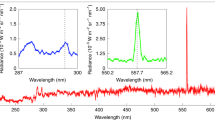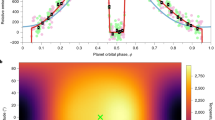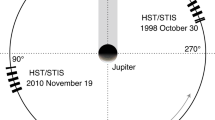Abstract
There is evidence for a morning–evening asymmetry for the 1.27 µ O2 band in twilight, and the evening decay appears slower at high latitude. No appreciable variation in the dayglow intensity has been observed with latitude ; the decreased dayglow intensity during an eclipse seems consistent with the theory involving production of O2(1 Δg) by photodissociation of ozone.
This is a preview of subscription content, access via your institution
Access options
Subscribe to this journal
Receive 51 print issues and online access
$199.00 per year
only $3.90 per issue
Buy this article
- Purchase on Springer Link
- Instant access to full article PDF
Prices may be subject to local taxes which are calculated during checkout
Similar content being viewed by others
References
Noxon, J. F., and Vallance Jones, A., Nature, 196, 157 (1962).
Evans, W. F. J., Llewellyn, E. J., and Vallance Jones, A., following article.
Gattinger, R. L., and Vallance Jones, A., Planet. Space Sci., 14, 1 (1966).
Badger, R. M., Wright, A. C., and Whitlock, R. F., J. Chem. Phys., 43, 4345 (1965).
Vallance Jones, A., Mém. Soc. Roy. Sci. Liège, 9, 289 (1964).
Noxon, J. F., and Markham, T. P., J. Geophys. Res., 68, 6059 (1963).
Hunt, B. G., J. Geophys. Res., 71, 1385 (1966).
Hesstvedt, E., Geofysiske Publikasjoner, 26, No. 1 (1965).
Author information
Authors and Affiliations
Rights and permissions
About this article
Cite this article
NOXON, J. Oxygen Spectra in Dayglow, Twilight, and during an Eclipse. Nature 213, 350–352 (1967). https://doi.org/10.1038/213350a0
Issue Date:
DOI: https://doi.org/10.1038/213350a0
This article is cited by
-
Day airglow
Space Science Reviews (1968)
Comments
By submitting a comment you agree to abide by our Terms and Community Guidelines. If you find something abusive or that does not comply with our terms or guidelines please flag it as inappropriate.



